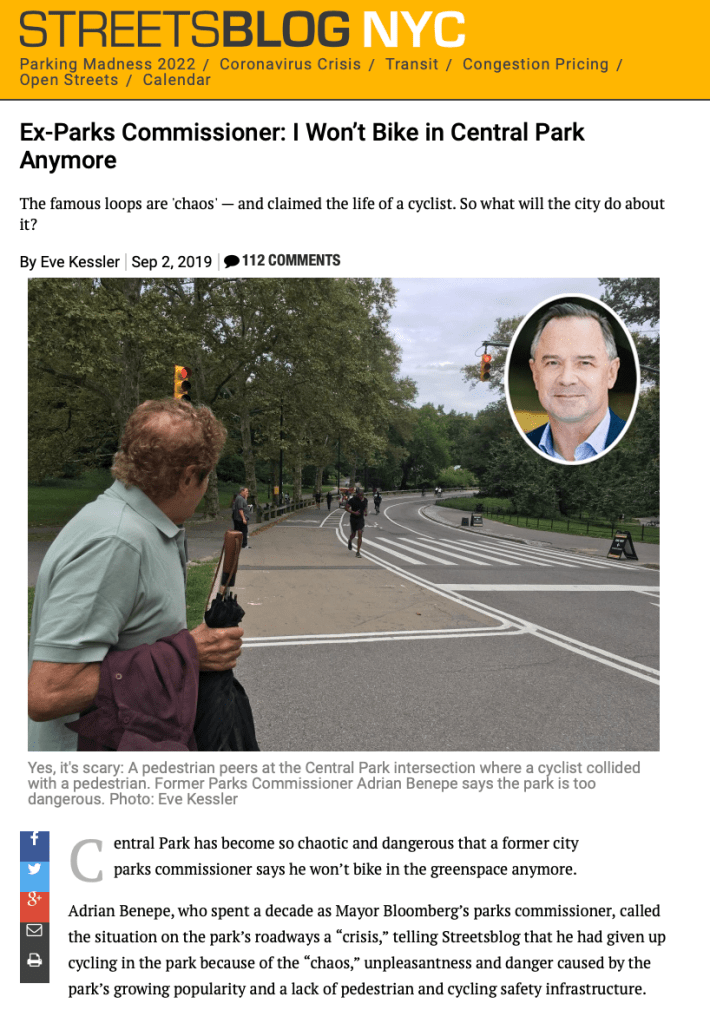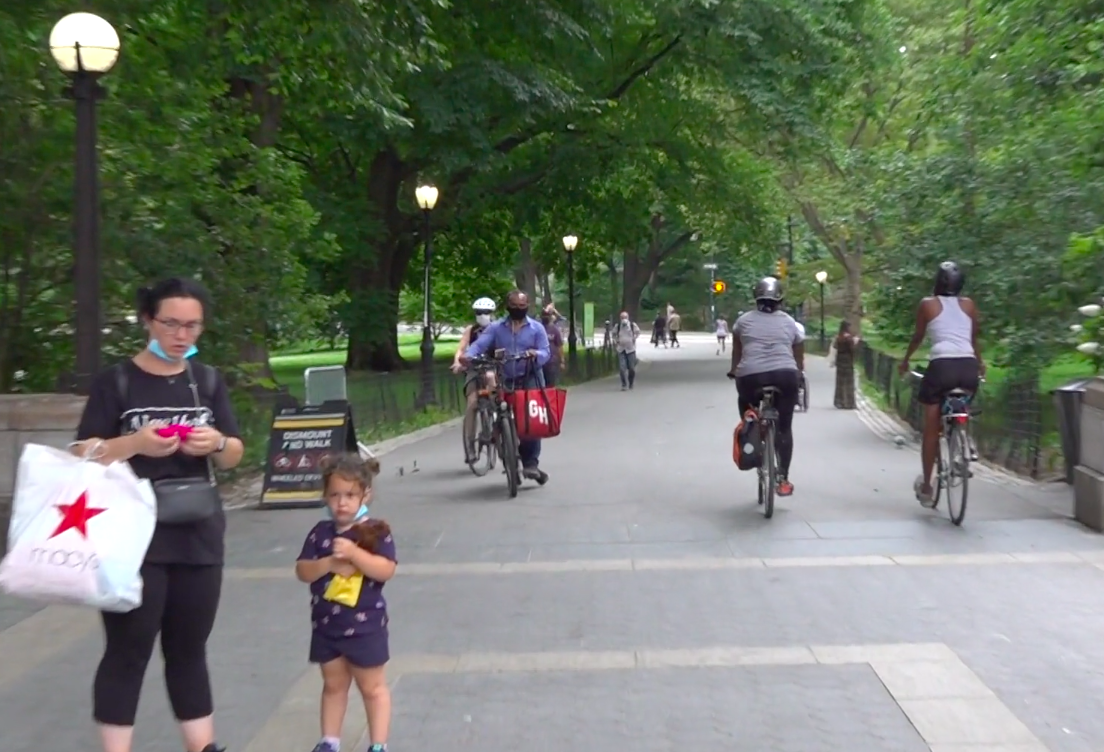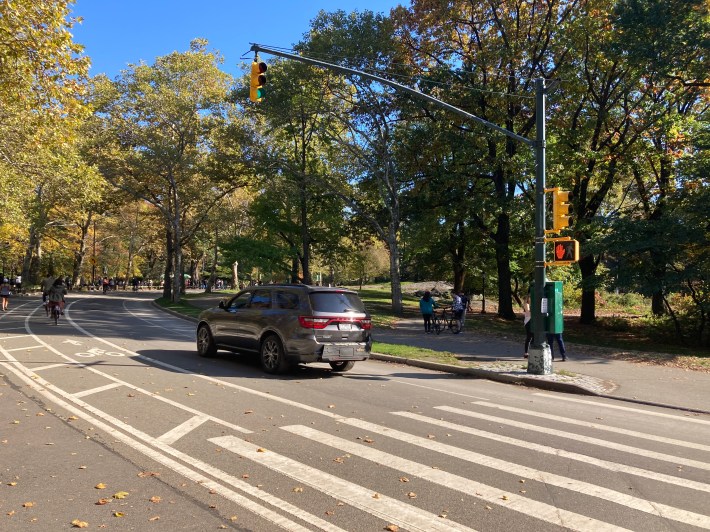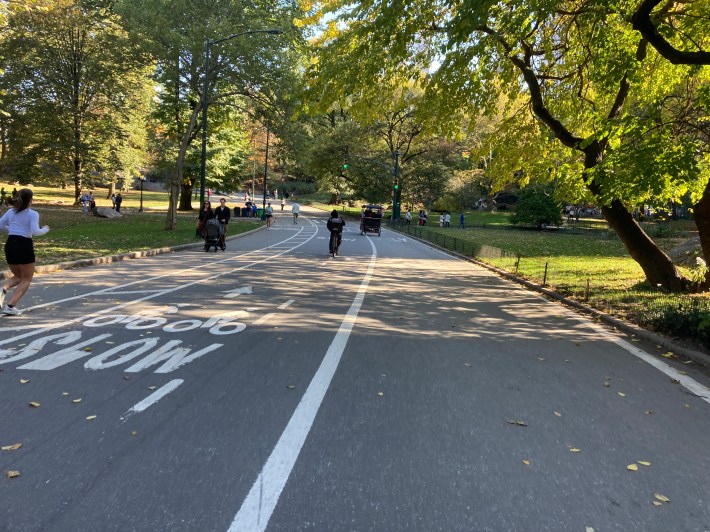The stewards of Central Park are reviving a long-overdue study to make the greensward safer for pedestrians and cyclists — as calls to redesign the “Wild West” roadways have intensified on the heels of yet another near-deadly collision between a cyclist and a jogger last month.
A spokesperson for the Central Park Conservancy told Streetsblog that it is dusting off a study that was first commissioned in 2018, when the park's roadways were made largely car free by then-Mayor Bill de Blasio.
The roadways were built in the 19th century for strolling, horseback riding, and carriages, only to be completely taken over by cars by the middle of the 20th century. Now they're used by cyclists, pedestrians, horse and carriages, and pedicabs carrying tourists — and have become so notoriously chaotic that even the former Parks Department Commissioner, Adrian Benepe, said he no longer bikes on them.
“As the Park’s steward, we work to maintain the Park as a place of respite for everyone. Our current challenge is to retain this core purpose of the Park while taking into account its unprecedented use by millions of people," the Central Park Conservancy spokesperson said, declining to answer any follow-up questions, including the timeline of the study, who is spearheading it, or what it involves.

It is therefore unclear if the study includes the park's transverses, which are the crosstown routes at 96th, 86th, 79th and 65th streets that are currently dominated by cars, trucks and buses, and a result, deadly for everyone else. Despite the danger, many cyclists use the transverse roads because paths through the park are (where it's legal to ride) hilly, indirect or shared with pedestrians. In other areas, signs tell bikers to “dismount and walk.”
But since the city took the bold laughably-not-bold-at-all step of banishing cars from the world's most famous park it has not reimagined the greenspace for its car-free reality; merely banning cars failed to solve the problem of keeping other road users safe and making it accessible for all.
"The park is heavily used by all sorts of people doing all sorts of activities," said Carl Mahaney, the director of StreetopiaUWS. "The loop is absolutely an issue, used by people moving at different speeds.
And calling it a "place of respite" ignores the fact that people also rely on it to get from home to school, work to home, from point A to point B, said Mahaney.
"It doesn't really square with the facts that thousands of people are using it as a greenway to get to work, school, on bicycles and e-cargo bike, delivery workers use it. We've been trying to get them to acknowledge that reality and take steps to accommodate that, and ideally encourage it and do so in a way that minimizes the conflict instead of ignoring," he said.
It's good the study is back on the park's radar, but something must be done urgently, advocates warn — people are getting hurt, including a 34-year-old woman who police say was hit and critically injured by a 50-year-old cyclist while she was jogging south on West Drive near W. 66th Street at about 7:45 a.m. on Oct. 26, just days before the New York City Marathon, when the construction of its pavilion encroaches on the loop's lanes.
The cyclist, who remained on the scene and whose name was not released by police, suffered a knee injury. As of this week, cops had no further information on the crash — or the status of the victims — and say the investigation is ongoing. The crash happened just days before the New York City Marathon,
That crash last week mirrors a similar one in August 2019, when 43-year-old Charles Cheeseboro, who was riding an e-bike, died from his injuries after colliding with a pedestrian on 74th Street on East Drive and hitting his head on the ground. Streetsblog reported at the time that Cheeseboro had wiped out at an especially dangerous crossing — a traffic-signalized intersection at the bottom of a relatively steep incline, and where traffic from three different sides converge.
And since the start of this year, within the Central Park Precinct, which spans only the 843-acre green space, there have been 56 collisions, resulting in 37 injuries, including five cyclists and six pedestrians, according to NYPD stats.
Now, there are three lanes inside the park that make up the loop, marked only by fading white paint. In a counterclockwise direction, the inner-most lane is typically reserved for people on foot, including walkers and joggers and those in wheelchairs; the middle lane is used by bikes and other mobility-type devices, and it's divided by slower-moving people on the left with those going faster on the right, meaning you – counterintuitively —pass on the right; and the outer-most lane is for vehicles, though not private.
But the lanes are often ignored, as are the traffic signals at major crossings. And there are few signs noting who should be where. (Plus, there are often still cars in the park, belonging to Parks Department workers and cops.)
“The outer lane is taken up by bikes all the time, the center lane is too narrow, especially on a nice day," said Mahaney.
Benepe is not alone in avoiding the loop. Upper West Side Council Member Gale Brewer says she’s received numerous complaints from constituents who have also boycotted the park.
“They are very concerned, as we all are, about the number of and the way in which we use the pathways. They are trying to figure out what to do about it. I get complaints from people, they’re no longer using Central Park, they’re afraid of getting hit,” she said.
One avid cyclist told Streetsblog that he still uses the loop, but only early in the morning. Otherwise, it’s too dangerous.
“I would never bike here during the day,” said Dean Kratsios. “People are really zoned out on their phones, not paying attention, going the wrong direction. It just takes one person going the wrong direction to have a catastrophic collision.”
Or even something as simple as clear signage would help, said Karen Kaapcke, who was heading uptown on her bike along Central Park West last week.
“The only kind of real problem is people going the wrong direction. Maybe a lot of tourists don't know. It would be good if signage was kind of obvious,” said Kaapcke, who added that she’s too scared to bike on the transverses.
Another suggested clearer and brighter paint on the ground.
“There’s a lot of confusion. We have a lot of tourists they are unaware fully unaware. Brighter lines, you gotta differentiate,” said Eric, who was biking the loop and declined to give his last name.
Urban designer and architect John Massengale told Streetsblog that, despite what some cynics may want, the solution isn't to ban e-bikes or even tourists who text while walking from from the park — it's to have fewer cars throughout he whole city, and create more space for people.
"We're just trying to squeeze too many people into leftover space, and it's causing conflicts between slow people, fast people, people walking, jogging," said Massengale. "The long-term solution is on the whole island, reduce car space, and increase space for everything else."
Update: this story has been updated to reflect that the Oct. 26 crash took place days before the New York City Marathon








